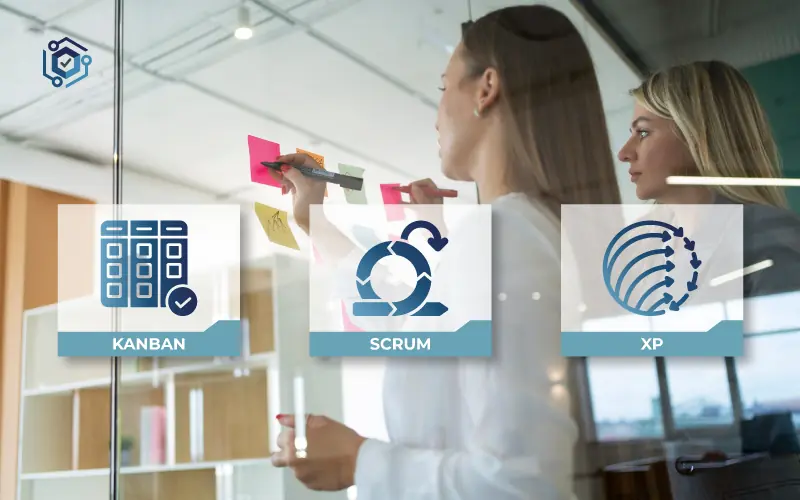Agile frameworks have revolutionized the way teams approach their work. These methodologies allow teams to adapt to rapid changes, collaborate effectively, and deliver value continuously. Among the most popular frameworks are Kanban, Scrum, and Extreme Programming (XP). Although they all share the agile philosophy, each has unique characteristics that make it ideal for different contexts and teams. In this article, we will explore what Kanban, Scrum, and XP are, their advantages and disadvantages, and how to choose the most suitable framework for your project.
What are agile frameworks?
Agile frameworks are methodologies that apply the principles of the Agile Manifesto: prioritizing collaboration, adapting to change, and delivering frequent and incremental results. While all aim to optimize workflow and improve team productivity, each framework adopts a different approach:
- Kanban: visual management and continuous flow.
- Scrum: organization based on short cycles and specific roles.
- Extreme Programming (XP): emphasis on technical quality and close collaboration.
Kanban: continuous flow and work visualization
What is Kanban?
Kanban is a framework based on a visual board to manage ongoing work. Tasks are represented as cards that move through columns indicating their status, such as “To Do,” “In Progress,” and “Done.” The focus is on limiting work in progress (WIP) to ensure that the team does not become overwhelmed and optimizes productivity.
Advantages of Kanban
- Flexibility: does not require defined roles or predefined cycles.
- Transparency: provides a clear view of workflow and possible bottlenecks.
- Ease of adoption: simple to implement in any type of team.
- Continuous improvement: allows for constant adjustments in the workflow.
Disadvantages of Kanban
- Lack of long-term structure: does not have an explicit time-planning system.
- Team dependency: if the board is not properly updated, transparency is lost.
- Absence of defined roles: can create confusion in teams without experience in self-management.
When to use Kanban?
- For teams working on continuous tasks such as maintenance, technical support, or marketing.
- In projects where priorities change frequently and cannot be planned in strict cycles.
For example, a customer service team could use Kanban to manage incoming requests, visualizing which ones are in progress and prioritizing the most urgent ones.
Scrum: iterative and structured organization
What is Scrum?
Scrum is an agile framework based on sprints, short cycles that usually last between 1 and 4 weeks. Each sprint aims to deliver a functional increment of the product. Scrum establishes specific roles, such as the Scrum Master (process facilitator) and the Product Owner (backlog manager), and uses regular meetings to plan, review, and continuously improve.
Advantages of Scrum
- Strong structure: helps maintain focus thanks to defined roles, artifacts, and events.
- Tangible increments: each sprint delivers concrete results that can be evaluated.
- Continuous improvement: retrospectives encourage the evolution of the team and the process.
- Close collaboration: involves the client and stakeholders in each cycle.
Disadvantages of Scrum
- Rigidity: can be restrictive for teams that prefer to work more flexibly.
- Commitment requirement: all members must adhere to the process for it to be effective.
- Frequent meetings: can be perceived as too time-consuming.
When to use Scrum?
- For projects with incremental deliveries and clear objectives, such as digital product development.
- In teams that need defined roles and responsibilities to work effectively.
A development team could use Scrum to build a mobile application, breaking down functionalities into sprints and delivering new versions every two weeks.
Extreme Programming (XP): technical focus and quality
What is XP?
Extreme Programming (XP) is an agile framework designed specifically for software development projects. It focuses on applying advanced technical practices such as pair programming, automated testing, and continuous integration to ensure product quality and customer satisfaction.
Advantages of XP
- High technical quality: emphasis on testing and standards ensures clean and functional code.
- Adaptability: can quickly adjust to changes in requirements.
- Intensive collaboration: promotes constant communication between developers and clients.
- Error reduction: frequent testing minimizes defects in the final product.
Disadvantages of XP
- High technical demand: requires developers with experience and advanced technical skills.
- Client dependency: needs active participation throughout the entire process.
- Less suitable for large teams: works best in small and highly collaborative teams.
When to use XP?
- In software development projects where code quality is a priority.
- For small teams working in dynamic environments with changing requirements.
A development team could use XP to create an e-commerce platform, constantly adjusting to customer needs while ensuring system stability.
Comparison between Kanban, Scrum, and XP
Although they share agile principles, each framework has a unique approach:
- Kanban: ideal for managing continuous work without defined cycles.
- Scrum: perfect for iterative projects with established roles and deadlines.
- XP: focused on technical quality and best software development practices.
How to choose the right agile framework?
Choosing between Kanban, Scrum, or XP depends on the specific needs of the project and the team:
- Kanban: if your team needs flexibility and is not constrained by deadlines, Kanban is a great option.
- Scrum: if you seek structure, constant collaboration, and periodic deliveries, Scrum is your framework.
- XP: if your priority is technical quality in software development, XP is the right choice.
Agile frameworks such as Kanban, Scrum, and Extreme Programming (XP) provide effective tools for managing projects in different contexts. Understanding their strengths and weaknesses will help you select the approach that best suits your team’s needs.
In the end, the most important thing is to adopt an agile mindset that promotes collaboration, continuous improvement, and delivering value to the customer. Beyond the framework you choose, true success lies in how teams apply agile principles to solve problems and achieve meaningful results.

